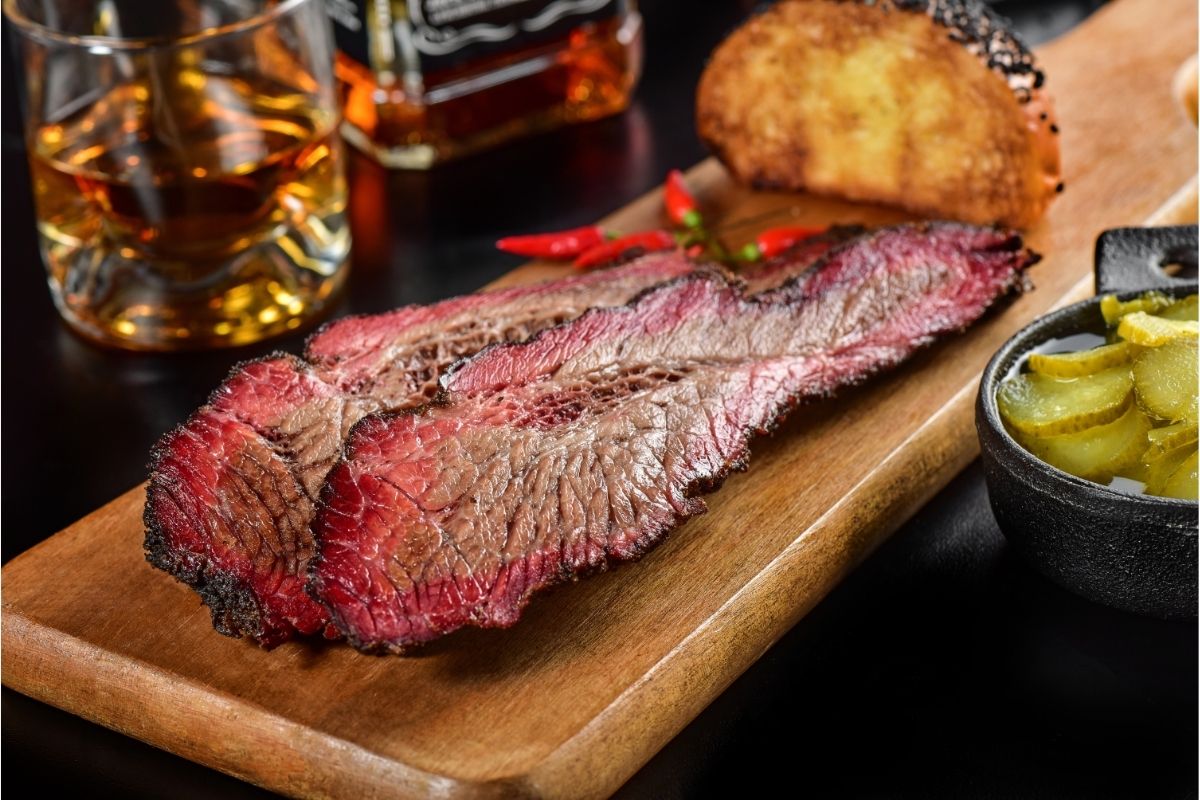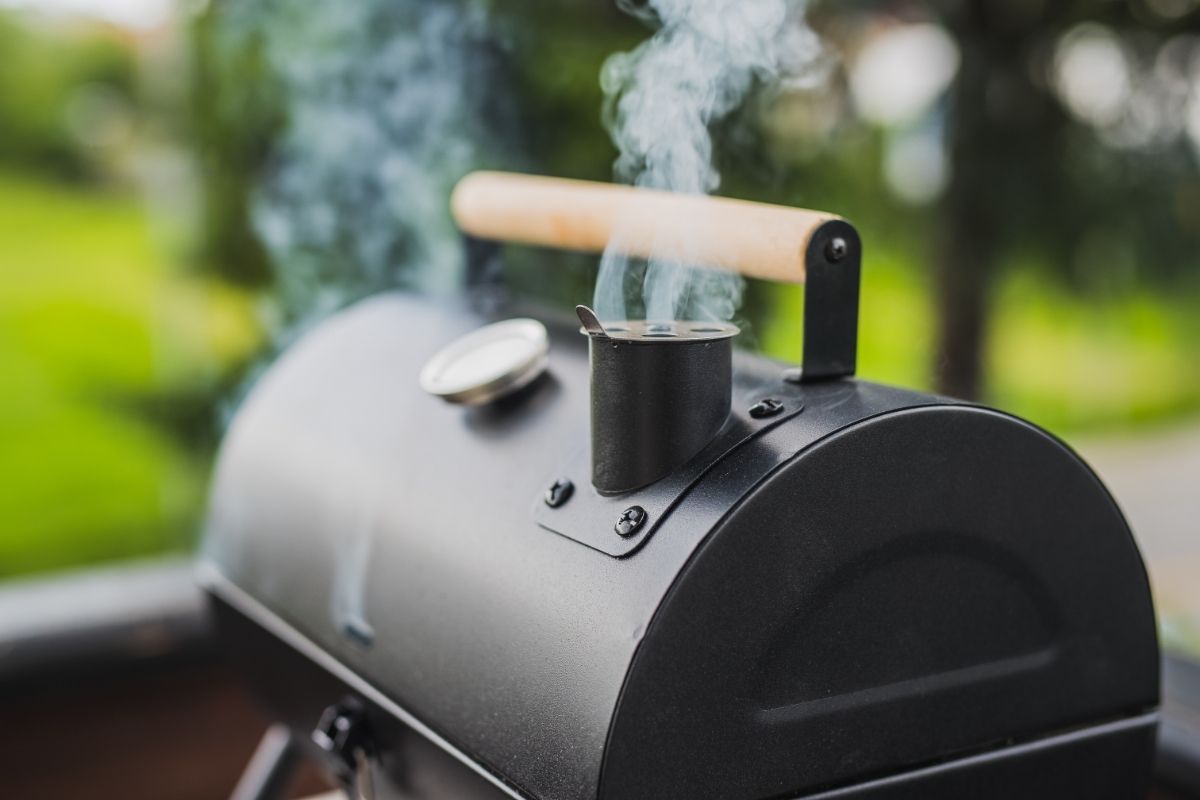Brisket is a type of beef cut that has a large amount of fat. This makes it very juicy and flavorful, but if you cook it wrong, it can become tough to eat.
As a result, brisket is often cooked slowly over low heat for hours or even days.

If you’re not familiar with cooking brisket, you might be wondering how long to smoke brisket at 225 degrees.
In this article, I will cover how long to smoke brisket at 225 degrees Fahrenheit, as well as some key information you should be aware of before cooking this joint of meat.
Without further ado, let’s begin.
When cooking brisket, it’s important to take it slow and steady. The key to tenderness is cooking it at a lower temperature for longer periods of time.
How Long Should You Smoke A Brisket At 225 Degrees Fahrenheit?
When it comes to smoking beef brisket at 225 degrees Fahrenheit, a joint of this size will typically cook at a rate of 1 to 1/2 hours per pound.
This means that the average brisket weighs around 10 pounds and will require approximately 16 hours of smoking time.
However, don’t worry if your brisket is larger than this because you can adjust the cooking time accordingly and still get great results.
In addition to this, it’s important to note that not every brisket will cook at the same rate, so you will need to take this information with a pinch of salt.
For the most accurate results, you will need to use this general rule of thumb in conjunction with the cooking instructions on the back of your brisket’s packaging.
Alongside this, it’s important to have a reliable meat thermometer on hand so that you can check the internal temperature of your brisket when you suspect that it’s done.
How Should You Maintain The Temperature Of Your Smoker?
Maintaining the temperature of your smoker is essential to the cooking time of your beef brisket.
If the interior temperature is constantly dropping below the ideal temperature of 225 degrees Fahrenheit, smoking your brisket will obviously take longer than planned.
In the same breath, if your temperature keeps shooting up, then you will likely end up with tough and dry meat.
To ensure that your smoker remains at a consistent temperature throughout the smoking process, you will need to make sure that your smoker is situated in a sheltered location.
The wind and cold temperatures can significantly impact the heat retention of your smoker, so the location is an important factor to bear in mind when positioning your smoker outdoors.
In addition to this, you will want to check the temperature on a regular basis.
However, if you find that you’re encountering these temperature issues frequently, then it might be time to replace your smoker.
How Do You Know When Your Brisket Is Done?
The easiest way to determine whether your brisket is ready to come out of the smoker is by checking its internal temperature.
You can do this by inserting a meat thermometer into the thickest part of your brisket. This will allow you to accurately gauge the temperature of your meat.
Once you’ve inserted the thermometer, leave it inside until the reading has stabilized. Once you see that the reading has reached 195 degrees Fahrenheit, you will need to remove the brisket from the smoker to rest.
As you allow the brisket to rest, its temperature will increase by another 10 to 15 degrees, meaning that its final temperature will be 210 degrees Fahrenheit.
The flat will be incredibly tender, making it a dream to carve it into neat slices. The point, on the other hand, can either be shredded or cut into cubes to make burnt ends.
If you do want to make burnt ends, you will need to place the cubes of point meat back into the smoker for a minimum of 1 more hour.
A Note On The Brisket Stall
If you’re not familiar with smoking briskets, you might not know about the brisket stall.
The brisket stall is when the internal temperature of the meat reaches 150 to 160 degrees Fahrenheit and appears as if it’s stopped cooking.
However, the brisket stall is all part of the process, and shouldn’t panic you! It’s normal for the thermometer to hit a plateau.
However, many barbecue enthusiasts work their way around the brisket stall by wrapping their brisket in aluminum foil when its internal temperature hits 150 degrees.
This can save you valuable cooking time, and is a super handy tip to bear in mind if you’re under time constraints.
That being said, you might decide to skip this step altogether and wait out the brisket stall the old-fashioned way.
This comes down to the fact that some people argue that it’s harder to achieve crispy bark on the outside of your brisket when it is covered by foil.
The choice is up to you, but the more experience you gain in smoking briskets, the more likely it is that you’ll develop a preference on the matter.
Can You Increase The Temperature Of Your Smoker?

It’s important to note that you should know the risk of doing so. Low and slow is the key to producing the best brisket.
You might think that you can increase the temperature of the smoker to speed up the cooking process.
However, just bear in mind that any sudden increase in temperature can cause your brisket to dry out and reverse all the hours you’ve spent making it a tender piece of meat.
You don’t want to ruin all of your hard work, so it’s much better to remain patient and allow the smoker to work its magic on your piece of meat slowly.
How Long Should You Allow Your Beef Brisket To Rest?
The resting period is essential to a mouthwatering brisket, and it’s not a process that you want to rush!
This comes down to the fact that if you skip the resting process, you will cause all of the delicious juices to leak out onto your chopping board, resulting in a much blander brisket.
You don’t want to ruin all your hard work, so resting the meat is a crucial step.
To ensure that your brisket remains as flavorful as possible, you will want to remove it from the smoker when its internal temperature reaches 195 degrees Fahrenheit.
Following this, you will need to wrap the brisket in aluminum foil and allow it to rest for a minimum of 30 minutes.
Allowing this rest period will allow the meat to rise in temperature and will also mean that the meat’s juices will remain inside the brisket and you won’t lose that flavor.
For the best results, never neglect resting your beef brisket after you remove it from the smoker.
Why Is Cooking A Brisket Low And Slow Important?
There’s no getting away from the fact that a brisket is a piece of meat that requires patience!
If you want a joint of meat that will fall apart in a matter of a few hours, a brisket is not the right choice for you.
The connective tissue of a brisket requires low temperatures and a slow cooking time to properly break down into a tender joint.
Allowing your brisket a long cooking time at a low temperature allows the fat in the meat to render, giving you a brisket that is juicy, rich, and very flavorful.
Cooking your brisket low and slow is the difference between a beautiful eating experience and an underwhelming one at best, and unpleasant at worst.
The reason why you don’t want to rush the cooking process with a brisket is that it will result in a tough piece of meat.
To avoid disappointment, you need to give this joint of meat time to break down in the smoker.
On the other end of the spectrum, if the temperature is too high, too much moisture will evaporate from the meat and you will be left with a dry brisket.
Have patience and allow your brisket the necessary time to cook in the smoker. Trust me, your guests will thank you for it!
Conclusion
Smoking your brisket at 225 degrees is an excellent way to achieve tenderness without sacrificing flavor.
However, it’s important to remember that there are many variables involved in determining how long to smoke briskets at 225 degrees.
As such, it’s best to follow these guidelines alongside the cooking instructions on the back of your brisket’s packaging.
Good luck smoking your beef brisket!
- The 9 Best BBQ Grills for Smoking Brisket - December 29, 2022
- 6 Mouth Watering Grilled Shrimp Recipes - September 16, 2022
- 6 Delicious Grilled Desserts - September 16, 2022
